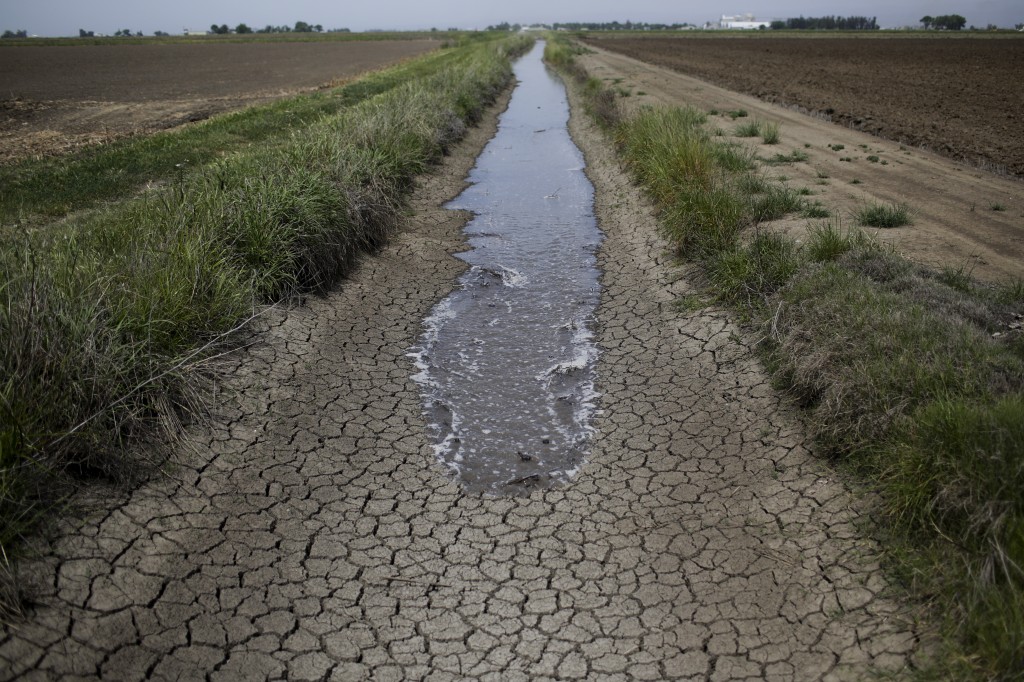- California Assembly OKs highest minimum wage in nation
- S. Korea unveils first graphic cigarette warnings
- US joins with South Korea, Japan in bid to deter North Korea
- LPGA golfer Chun In-gee finally back in action
- S. Korea won’t be top seed in final World Cup qualification round
- US men’s soccer misses 2nd straight Olympics
- US back on track in qualifying with 4-0 win over Guatemala
- High-intensity workout injuries spawn cottage industry
- CDC expands range of Zika mosquitoes into parts of Northeast
- Who knew? ‘The Walking Dead’ is helping families connect
Report: Groundwater pumping in California has land sinking

In this May 1, 2014 photo, irrigation water runs along the dried-up ditch between the rice farms to provide water for the rice fields in Richvale, Calif. (AP Photo/Jae C. Hong)
FRESNO, Calif. (AP) — Vast areas of California’s Central Valley are sinking faster than in the past as massive amounts of groundwater are pumped during the historic drought, state officials said Wednesday, citing new research by NASA scientists.
The data shows the ground is sinking nearly two inches each month in some places, putting roads, bridges and vital canals that deliver water throughout the state at growing risk of damage.
Sinking land has occurred for decades in California because of excessive groundwater pumping during dry years, but the new data shows it is happening faster as the state endures its fourth year of drought.
“We are pumping at historic levels,” said Mark Cowin, head of the California Department of Water Resources. He added that groundwater levels are dropping to record levels — up to 100 feet lower than previously recorded.
Scientists at NASA’s Jet Propulsion Laboratory did the research using images taken over time from satellites and airplanes.
California is the nation’s leading agriculture state, but drought has put one-fifth more land out of production this year than last year.
Gov. Jerry Brown signed historic legislation last year that requires monitoring of groundwater pumping. However, local officials have until 2020 and in some cases until 2022 to write their management plans, so it could take another decade or two before California has a handle on groundwater use, Cowin said.
“I don’t think we can end overdraft or subsidence overnight,” he said. “We do need to take action.”
Meanwhile, the Department of Water Resources is launching a $10 million program to help counties with stressed groundwater basins to develop or strengthen local ordinances and conservation plans.
The NASA data shows land near the city of Corcoran sank 13 inches in eight months, and part of the California Aqueduct dropped eight inches in four months last year. The aqueduct spans hundreds of miles and provides water to million people and about vast areas of farmland.
Farmers in the Central California Irrigation District have spent $4.5 million to raise the walls on a canal and intend to pay $2.5 million to raise a bridge above the water.
“It’s a vivid picture of what subsidence can do,” said Christopher White, manager of the district that serves 1,900 farmers, who grow tomatoes, cotton, fruit, almonds and other crops in three counties.
Long-term subsidence has already destroyed thousands of public and private groundwater well casings in the San Joaquin Valley. Over time, subsidence can permanently reduce the underground aquifer’s water storage capacity.
Lester Snow, executive director of the California Water Foundation, which promotes water policy, urged more immediate action. He said state and federal officials should also offer local agencies financial incentives to reduce reliance on groundwater.
Investments are also needed in storm water capture during wet winters to offset heavy reliance on groundwater, Snow said.
“As long as this continues, we risk further damage to roads, levees and buildings,” he said. “There is no time to waste.”
















